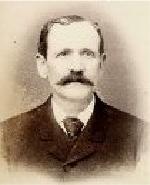Deadwood The Commercial and Social Hub of the Black Hills’ Universe by Ann Haber Stanton
Ann Haber Stanton
South Dakota Jewish Historian
Photo courtesy Ann Stanton
1876 was an extraordinary year in the Black Hills. Discovery of mineral treasure opened the door to a deluge of exploration, immigration, and settlement that would change the landscape forever. Deadwood, at first just a series of mining camps downstream from the mother lode, soon became the commercial and social hub of the Black Hills’ universe.
Not every mining endeavor would fulfill its expectations. This was the case for a small party of gold prospectors led by John Brennan. After months of fruitless toil high in Palmer Gulch, beneath the shadow of Harney Peak, still in the grip of a Dakota winter, a more expansive plan developed. Brennan recognized the need for a central location, a town that would connect thriving Deadwood and the surrounding mining and timber camps with each other and with other cities. Brennan envisioned a “new Denver”- a “gateway” in the foothills, close to clean water and good grass and fertile ground, easily accessible by road and rail. A town could be developed and commerce established.
In February of 1876 Brennan and his party descended to a spot in the foothills, where they pitched camp alongside Rapid Creek, in the shelter of a prominent rocky cliff. The next day another small party joined them. Using Brennan’s compass, Sam Scott, a seasoned land surveyor, surveyed a townsite. William Martin named it Rapid City, “Rapid” for the waterway, and “City”, in anticipation of its importance to the Black Hills and its prospect for prosperity, and a “city” was born.
Here there was no mining, no particular mineral treasure. It was all about “location.” The good grass, ideal for grazing livestock and resting oxen, would earn the town the nickname “Hay Camp”. The level route through Centennial Valley made for easy access to Deadwood and points north. Points east and south were similarly convenient. The rocky cliff became the signpost and Rapid City would indeed become the Gateway to the Black Hills.
Commerce began to flow between the Hills towns. John Brennan became Rapid City’s first mayor, and started one of the first hotels. Sam Scott jumped right into the real estate business. William (Billy) Nuttall, another of the founders, and a young man with a taste for the wilder side of life, headed for Deadwood, where he applied his entrepreneurial skills to the theater business, starting by buying the Bella Union theater and saloon.
Deadwood merchants like grocerymen Hermann and Treber, and Jacob Goldberg, and dealers in liquors and cigars, Harris Franklin and Ben Baer, set up satellite wholesale houses for their popular merchandise in Rapid City. Although Brennan and Scott set down roots, Tom Ferguson, like most of Rapid City’s original founders, left. Some headed for Deadwood, still hoping to find their bonanza in the northern Hills.





0 comments:
Post a Comment